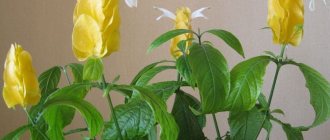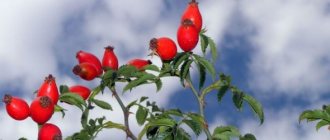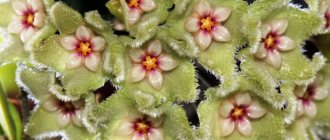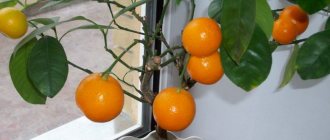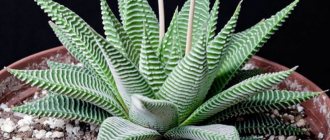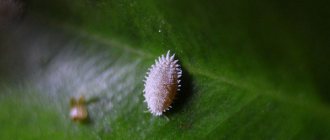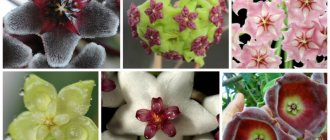Soil for hoya: selecting the soil mixture for wax ivy correctly
Suitable soil is one of the main conditions for successfully growing indoor flowers, especially when it comes to exotic representatives of the flora.
After all, hoyas are not quite familiar plants to us, but wax ivies, epiphytic inhabitants of the tropics and subtropics. In nature, many of them wrap their shoots around stronger tree-like specimens, using them as a support. But they feed on their own, extracting nutrients from the soil and air. What should the soil be like for hoya grown at home? What features of these epiphytes is best for a gardener to know in advance?
Description of varieties
The evergreen vine, which is known as Hoya fleshy, or wax ivy, has a well-developed root system and a branched stem up to 10 m long, covered with hard, pointed leaves.
Flowering, during which fragrant flowers of various colors bloom, collected in umbrella inflorescences, occurs in the summer. Breeders have developed many varieties of Hoya carnosa, which differ in shape, color of leaf blades and flowers.
Among the most common and original representatives of the type species are:
- Variegata - form with pink flowers bordered by a white stripe;
- Exotica - a distinctive feature of the variety is the yellow color of the leaf blades, gradually acquiring a green tint towards the edges;
- Tricolor - a variety with leaf blades edged with a green border, which change the main color from red to yellow as they mature;
- “Crimson Queen” - the variety stands out for its rich pink flowers with a more delicate border around the edges.
Home care
Despite its exotic nature, the indoor plant Hoya carnosa is not capricious, so caring for it will not cause any trouble for the gardener.
Soil composition and pot selection
When choosing a pot for a vine, you must remember that the hoya will not bloom until its roots completely entwine the earthen ball.
For this reason, preference should be given to small but tall pots or flowerpots if the gardener plans to grow the plant as a hanging plant.
A properly selected container is filled with loose, nutritious soil, which you can make yourself from leaf soil, turf soil, humus, sand in a ratio of 3:2:2:1.
It should be heated in the oven to destroy infection and insect larvae. You can also purchase the substrate in the store, choosing a soil mixture for palm trees.
Watering Hoya Carnose
The exotic flower should be watered sparingly after the earthen ball dries to the depth of the phalanx of the finger. In summer, weekly watering is enough for the vine.
With the arrival of winter, if the crop is kept in a room with a low temperature, the crop will need to be moistened only once every 2 to 3 weeks. Water procedures are carried out with settled water. In this case, it is necessary to ensure that water does not remain in the pan, which can lead to the development of gray rot.
Fertilizer application
The Hoya carnosa flower only needs additional nutrition every 2 weeks in the summer. For fertilizing, liquid mineral fertilizers for flowering plants with a high phosphorus content are used.
Planting and transplanting
The plant tolerates transplants painfully, so after purchasing a flower, you should give it time to acclimatize, and then carefully transplant it from the shipping container into a pot of similar diameter. A drainage layer must be placed at the bottom of the permanent container.
After planting, the hoya is not watered, but only sprayed
A drainage layer must be placed at the bottom of the permanent container. After planting, the hoya is not watered, but only sprayed.
Subsequently, replanting is carried out after 2 - 3 years, when the roots appear from the drainage holes, demonstrating that the pot has become too cramped.
Trimming
The flower does not need pruning, since new inflorescences appear on the old arrow. For sanitary purposes, only damaged leaves can be removed with a sterile instrument.
Features of reproduction
At home, Hoya is propagated by cuttings. The apical cuttings are cut 10–15 cm long so that they have 2 internodes. Hoya takes root both in water and in a moist substrate of peat and sand. If you create greenhouse conditions for the cutting by covering it with a plastic cap, the rooting process will speed up.
Plant diseases and pests
Like other succulents, the vine can be attacked by whiteflies, spider mites, mealybugs and scale insects.
To quickly and effectively deal with emerging pests, you should resort to spraying with an insecticidal preparation according to the manufacturer’s instructions.
The plant is not susceptible to diseases, but when water stagnates in the roots or when the soil is systematically waterlogged, gray rot may develop. To prevent disease of the graceful vine, the watering regime should be strictly observed.
A little about the beauties-hoyas
Hoya is a genus of evergreen tropical plants from the Lastovneve family. They are found in nature in South Asia, the islands of the Malay Archipelago, and the tropical forests of Australia and Polynesia.
Most representatives of the genus are strong, climbing vine-like plants, less often - shrubs, with glossy, bright green foliage. It blooms profusely, with clusters of calyx flowers that have an intense aroma, especially pronounced at night.
The genus has about 2 hundred species, however, two of them are most often grown as indoor and greenhouse flowers - hoya carnosa (fleshy) and beautiful (bella).
What should the soil be like for hoya?
If we talk about the popular types of hoi - carnose and bella, they are relatively unpretentious and not particularly sensitive to the quality of the soil. However, in the collections of flower growers there are also rarer and capricious varieties. And in addition, it is important to take into account the exotic origin of the plant, because if the maintenance is seriously violated, the vine will not only not bloom, but may also stop growing and even die.
Attempts to grow this exotic plant in garden or garden soil most often fail, which means it is still worth paying more attention to this aspect. For better results, it is recommended to prepare a breathable, moderately light and nutritious substrate yourself.
Recipe No. 1
The multicomponent composition makes it possible to make the mixture most suitable for epiphytes. The following ingredients will be required:
It is recommended to add a little dolomite flour, charcoal and pieces of pine bark to the resulting substrate.
Recipe No. 2
Hoya soil can be prepared from fewer ingredients:
Additional desirable ingredients are sphagnum moss, shredded bark and charcoal.
Recipe No. 3
Some Hoya owners have abandoned the use of traditional products - sphagnum, coconut coir and bark. There is also a substrate option for these epiphytic plants; for this, the following products are mixed in equal parts:
You can add part of “Ceramis” to the composition - a natural clay granular soil, which is suitable for growing indoor and garden vegetation. The granules absorb moisture when watering and function as a natural automatic watering system.
But, even without the last ingredient, the soil substrate turns out to be moisture- and water-permeable.
Recipe No. 4
The soil for hoi has similar properties to the substrate for orchids, so sometimes gardeners take the simple route, mixing ready-made soil for orchids with ordinary soil from the garden. But, hoyas require a substrate of a more complex composition, so it is best to add organic and inorganic components to mixtures for orchids:
There are many variations in the composition of soil mixtures for Khoi, however, it is worth considering the variety of your pet, since the needs and preferences of epiphytes of different species and varieties may vary.
Types of flower
Based on the description of Hoya, it is easy to determine the specific variety. Among the representatives you can find plants of different shapes and colors. Such vines will be a beautiful decoration for your home.
Hoya compacta is distinguished by twisted leaves that are planted very close to each other.
Variegata has cream-colored leaves with a green edge. This variety has pink flowers. Tricolor combines the rich purple color of the leaves with a long flowering period - up to six months.
Hoya carnosa grows quickly and is easy to care for. Lianas beautifully entwine walls or special supports. With the help of such a plant you can decorate any home.
https://selo.guru/rastenievodstvo/sukkulenty/hoiya/vidy-ho/karnoza.htmlhttps://pocvetam.ru/komnatnye-rasteniya/dekorativno-listvennye/khoyya-karnoza.htmlhttps://greensotka.ru/hishchnye/ hoja-karnoza.html
The nuances of growing epiphytes and tips from experienced gardeners
Experienced Hoya owners usually resort to various kinds of experiments and, through trial and error, find out what is best for their exotic pets. You can resort to their recommendations and advice to avoid possible mistakes:
Hoya compacta and Kerry are not particularly demanding and feel good in any loose soil, the main thing is not to let it become waterlogged. But, they need additional feeding more than others.
Regardless of the type of plant and soil substrate used, there must be drainage at the bottom of the pot. Many gardeners do not recommend using expanded clay for these purposes, as it retains water. The simplest drainage is considered to be polystyrene foam; it can be left after purchasing household appliances, and then placed in pieces on the bottom of the container.
Hoyas can be fed with long-acting fertilizers for flowering crops. But mixtures for tomatoes are also “tasty” for these epiphytes; their sodium-fluorine-potassium ratio is perfect for these flowers.
Substrates for hoi
| Quote |
| Joker writes: You can add calcium for some types (dolomite or broken shells). |
And I really liked the “Gardens of Aurica” at one time. I had many sitting in it, I only picked out pine needles and moss before planting.
In the section “Palmaceae family” there is an article about care. Excerpt about soils: “In what soil should I plant a rooted cutting? There is no universal recipe. Firstly, the preferences of the Khoi, determined by their natural origin, are very diverse. Secondly, they quite successfully adapt to the preferences and material capabilities of their owners. There are people who quite successfully grow hoyas in the most ordinary soil from a flower shop. However, most still try to create more suitable conditions for their plants. Therefore, we advise you to approach this issue creatively. Try to learn as much as you can about the natural origins of your plant, and don't let anyone's practical advice override your logical thinking. This is not always justified. For many Hoyas, a mixture of the following composition is suitable:
* 1 part perlite or vermiculite; * 1 part of fine expanded clay; * 1 part sphagnum moss or peat; * 2 parts regular plant soil.
For varieties that are sensitive to drying out, you can add more sphagnum moss. You should not add sand to the mixture, as this will cause it to dry out and cake faster. But sensitive and fastidious H. serpens and H. curtisii, for example, will feel much better in an orchid substrate or a substrate based on coconut fiber. Some collectors grow all their hoyas in orchid substrate. Some people fill the pot halfway with it. As a filler for the remaining space, garden soil mixed with slaked lime or a soil mixture containing the above ingredients in one ratio or another is used. All Hoyas need a breathable substrate. The final choice is yours. "
Epiphytic plants in potted plants need a very air- and water-permeable substrate, which is also coarse and at the same time light, and also contains a lot of humus. The substrate should be well soaked and dry relatively quickly. As a base, you can use a mixture for orchids or anthuriums. This mixture should be improved in content with various additives, and the lightest components should then be blown out or removed by sifting. Sand, stones and clay shards are not suitable for the Khoya mixture. A fairly good earthen mixture can be obtained by mixing the following components:
Organic components (acidic): - ready-made flower mixtures (for orchids or anthuriums) - pieces of peat (2-5 mm) (used in filters for ponds) - pieces of peat (5-20 mm) (used in filters for ponds) - bark pine (medium size) - sphagnum
Inorganic components (neutral): - charcoal (5-15 mm) - mineral soil for aquariums - pumice pebbles (2-6 mm) - zeolite - expanded clay for hydroculture (4-8 mm) - expanded clay "Ceramis" - foamed polystyrene closed cell (pillow filling)
For terrestrial species of Hoi (Eriostemma group), a little more limestone is added to the earthen mixture, for example, well-washed shells. But still, every Hoi lover should experimentally find out the optimal soil mixture for his plants. Alternatively, hoyas can be converted to hydroponics/hydroculture, but the water level and fertilizer content in the solution should be low. Growing epiphytic plants and succulents hydroponically is a matter of taste. But isn’t it surprising to you that hoyas feel great both in dry, humus-rich soil and in water?”
Source
Reproduction
Most often, hoya is propagated by cuttings - this is the simplest and most effective way. Propagation by seeds is extremely rare. Hoya does not set fruit in captivity. And you can’t even find them on sale; they have a very short shelf life.
After pollination, a pod appears on the hoya; after ripening, you will find fluffy seeds in it.
Cuttings
- In the spring, cut cuttings (10 cm) of hoya from the tops of last year's shoots. Each one should have at least 2 internodes, and preferably 3–4.
- Treat the cut of the cutting with a phytohormone (Epin, Zircon, others).
- Fill the container with a mixture of peat and sand and moisten it.
- Deepen the cuttings, carefully compact the substrate, leaving no voids.
- Cover the seedlings with film, a bag or a jar.
- Place in a bright and warm (18–24 0 C) place.
- Moisten and ventilate the plantings regularly.
- When new leaves begin to appear, transplant the cuttings into small (7–10 cm) pots with hoya soil.
You can root cuttings in an improvised greenhouse
Video: rooting hoya cuttings in different soils
Botanical portrait
Hoyas are perennial plants with climbing, climbing, and sometimes drooping stems. Their leaves are fleshy, leathery, deep emerald in color, with a characteristic sheen, up to 20 cm long, 5 cm wide, located oppositely along the pagons.
The flowers have a complex structure, are snow-white, cream, lemon yellow, pink or salmon-scarlet, collected in axillary inflorescences. The corollas are five-lobed, the petals are fleshy, smooth, and feel like velvet.
The most popular types in indoor culture are:
Types and varieties of Hoya
In indoor floriculture, Hoya is grown in different ways:
- as an ampelous plant in a flowerpot;
- like ivy around a support;
- like a bush with an erect stem.
To do this, select the appropriate type of Hoya.
Hoya majestic
The homeland of Hoya Majestic or Imperial (Hoya imperialis) is the Malacca Peninsula. Grows as a climbing shrub. The leaves are oval-shaped, oblong, with a slightly pointed tip. They are large, up to 20 cm in length. The surface of the leaves is smooth and leathery. The flowers are collected in hanging umbrellas of 6 - 10 pieces. They are dark red inside and yellowish green outside. Their petals look like stars and smell pleasant.
Hoya Beautiful
Hoya Bella is an ampelous type of plant. Brought from India, perfectly adapted to high room temperatures and humidity. It has the appearance of a small shrub with creeping shoots, which are covered with small, thick, pointed leaves up to 2.5 cm in length. It blooms with medium-sized white flowers, the crown of which is a unique red or red-violet color. Blooms profusely throughout the summer. The aroma of this type of Hoya is less pronounced than others, so the flower can be placed almost anywhere in the apartment.
Hoya Greenflower
Hoya Chlorantha is a very showy plant with elongated leaves and velvety flowers of white, brown or greenish color.
Hoya Fleshy
Hoya Carnosa is a very popular vine among gardeners. It grows naturally in India, China, Vietnam, Malaysia, and Japan. Reaches a length of 6 meters. It is necessary to tie it up or install a ring support so that the thin stems of the plant wrap around it. This type of vine has different flowers depending on its variety. Thus, the variety Variegata has flowers of a pinkish tint with a white edge, and Tricolor has leaves that have a green edge, and the middle is first colored red, and changes to yellow as it grows. Hoya Exotica has leaves with a yellow center and green edges. The Crimson Queen variety has bright pink flowers with a pale pink edge.
Hoya Motoskei
Hoya Motoskei is a long, up to 6 meters, vine with drooping creeping stems. Its dark green leaves are oblong or heart-shaped. They are fleshy and shiny in appearance. The leaf length reaches 8 cm, and the width is up to 4 cm. The flowers of the vine are pale beige or white, with a pink crown in the center. They are collected in umbrellas and have a very pleasant aroma.
Hoya Multiflora
Hoya Multiflora was brought to us from Malaysia. It grows in the form of ivy with linear oblong leaves. It blooms early with long orange flowers with narrow yellow petals in the shape of a star with a tip-shaped center. It most often has large leaves, although there are species with small leaves.
Hoya Kerry
Hoya Kerri is another ivy-like species. This variety of Wax Ivy was discovered in 1911 by the American scientist A. Kerry in northern Thailand. This vine was named in his honor. Very beautiful view. Long stems need staking. The pubescent flowers are collected in spherical umbrellas of 15 - 25 pieces. Their color depends on the plant’s exposure to sunlight: from white with a barely noticeable lemon tint to yellow-lemon and pinkish. The older the plant, the darker its flowers become. It is distinguished by an unusual leaf shape - in the shape of a heart. This flower is called Valentine or Hoya of lovers. In order to grow this amazing plant, it is enough to plant one heart in the ground - very soon it will take root.
Hoya Concave
Hoya Lacunosa lives in Malaysia. It has small diamond-shaped leaves, light green in color with a darker edge. Flowers have a subtle, pleasant aroma, similar to perfume. This type of vine is considered the most unpretentious to care for and is very popular among novice gardeners.
Hoya Cupulata
Hoya Cupped (Hoya Calycina) is an upright plant species. Its difference is in the leaf plates - they are the longest, up to 20 cm in length.
This may be interesting: Decembrist (Schlumbergera, Rozhdestvennik, Zygocactus) - care, reproduction and disease
Hoya propagation at home
Flower growers practice sowing seeds and rooting stem cuttings. With a certain amount of patience, it is possible to grow hoya from a separate leaf blade. Before propagating hoya at home, you need to familiarize yourself with the existing methods of obtaining new plants.
The best time to propagate hoya is the beginning of the growing season. Although the plant does not have a pronounced rest period, during the cold season of the year the growth processes of the vine slow down. With the arrival of spring, hoya can be propagated more effectively, although you can experiment with rooting shoots in other months, but not at the time of flowering.
Hoya: propagation by cuttings
The cuttings are cut from a healthy pagon.
It should be short - 5-6 cm, consist of two internodes and 1-2 pairs of leaves. The lower leaf blades are removed, leaving only the upper pair. Before rooting the hoya, the cutting is dried for a couple of hours, then the cut is treated with a root formation stimulator - heteroauxin, zircon or root and buried in a soil mixture or in a vessel with water. Substrate options for rooting cuttings:
A bowl with a cutting placed in water or a substrate is covered on top with plastic film or glass and regularly moistened with a spray bottle; do not forget to ventilate quite often. Experienced gardeners use plastic bottles with the bottom cut off and provide air access by unscrewing the cap.
The vessel with the rooted cuttings is placed in a warm place where it is possible to constantly maintain a temperature of 22 degrees Celsius. The roots will appear after 2 weeks. The plant is transplanted into a separate pot without waiting for the root system to develop, because, as they lengthen, the fragile roots easily break during transplantation.
Hoya propagation by leaf
A leaf that is healthy and young is selected, and it is cut off with a small fragment of the petiole - this is where the growth point is located.
This is important because, cut off at the very base, it will remain a leaf blade sticking out in the ground, albeit with roots, and will not form a shoot. The method of obtaining a new specimen from a separate leaf is similar to how hoya is propagated by cuttings. The planting material is also dried and treated with root or other root formation stimulant. The composition of the soil mixture is the same, however, several leaves are planted in a tight pot and fed periodically. It will take a long time, about a year, before a pagon forms from a rooted leaf.
Growing Hoya from Seeds
In indoor conditions, the pollination process is difficult, and it is almost impossible to become the owner of planting material. However, if you're lucky, you can purchase it at a specialty store or order it from suppliers. Hoya seeds in the photo look small, hemispherical in shape and dark chestnut in color, with a characteristic fluff, like a dandelion. They ripen in small pods. They should be sown in a soil mixture consisting of leaf and turf soil mixed with chopped sphagnum moss in the year of collection.
Shoots appear quickly, in about a week. The soil is constantly watered, but make sure that excess water flows into the pan through the drainage holes. The container with the seedlings is kept in a warm corner of the room, and after about 3 months the plant with 2-4 leaves is planted in separate containers. To prevent fungal infection, periodically spray with Bordeaux mixture.
Knowing how to grow hoya from seeds, many new specimens are obtained, but this method is not entirely suitable for hybrid plants - the parental characteristics of the variety are often lost.
Hoya in different seasons
This plant blooms even in winter. If you want to create such beauty for yourself, then you need to prepare the flower for this in September. To do this, place the container with the plant on the east side.
At the beginning of winter, the flower is watered very little, and as a result, flowers appear on the plant. The most ideal temperature for this period of time is 15 degrees Celsius.
There are also types of hoya that do not like coolness; these include multiflora. If the temperature is below 20 degrees, then it loses leaves and flowers.
As a rule, winter is an opportunity for Hoya to rest, and at this time it is better to water and fertilize it less. It blooms in the warmest times of the year, just when it needs constant care. And all this time the flower needs light.
Hoya transplant at home
Hoya does not like frequent transplants. An adult plant is moved to a new substrate once every 2-3 years, young specimens - annually. It is always important for a novice gardener to know what kind of pot is needed for hoya and how to plant the plant correctly, selecting the most necessary components to compose the soil mixture.
Choosing a pot and transplanting time
The succulent grows poorly in spacious containers, weakly increases its vegetation mass, “sits” in place for a long time and refuses to bloom. Therefore, it is advisable to plant the plant in a small pot. The material from which it is made does not play a significant role. The gardener just needs to remember that moisture evaporates from a clay container faster than from a plastic one, and the watering regime will have to be adjusted accordingly.
When to replant hoya is also important. You should not start replanting on the eve of the winter season; it is better to wait until spring.
Plants moved to a new soil mixture in the fall do not take root well and often die over time, never recovering from the replanting measures.
Earth mixture for growing hoya
Soil for hoya can be purchased from a specialized flower shop or you can make your own substrate. The following selection of components is possible:
For planting more mature plants, add 0.5 parts of humus. The Hoya is watered well the day before so that no problems arise when removing the flower from the old pot.
For Hoya beautiful, you need a slightly different composition of the soil mixture - 1 part each:
How to plant hoya correctly?
It is advisable to disturb the roots to a minimum; if possible, use the transshipment method. The root collar is buried at the same level as in the previous container. Place the plant in the center of the pot, holding it with one hand, carefully add soil so as not to damage the roots. If the hoya has long stems, before moving the plant to a new container, strengthen the support in it, and then plant the flower so as not to injure the root system by driving a peg into the substrate.
The main condition for replanting is that the soil for hoya should be loose, air- and moisture-permeable, with a neutral or slightly acidic reaction.
Diseases and pests
As with other indoor vegetation, this ivy most often suffers from improper care and unsuitable conditions. Less often it is overcome by various pests and infections.
Fungal diseases
If hoya is infected by phytopathogenic fungi, it stops growing, and the foliage turns yellow and withers, and in addition, depending on the type of pathogen, other symptoms of the disease appear:
- Powdery mildew - occurs as a result of excess moisture. A light waxy coating appears on the foliage, which quickly covers the entire vine. Having discovered a lesion, the grower must immediately remove the infected parts of the flower.
- Sooty fungus is a secondary parasite that settles on the secretory fluid secreted by other insects. The fungus covers the leaf blades with a film, which is why the plant cannot fully breathe.
- Rust - orange or reddish spots and edging appear on the vine.
Hoya can be saved from these diseases if you respond in a timely manner. A set of measures will be required:
It is important to immediately trim off all affected areas of the flower. The next step is to transplant the plant into another pot with new soil. Hoya should be treated with fungicidal preparations, this could be Topaz, Bordeaux mixture, a sulfur or copper compound.
Rot infestation
They develop when the flower is constantly kept in cold conditions, with an excess of nitrogenous substances and overwatering. Most often it occurs when there is excess moisture in an earthen coma: the roots rot - they soften and acquire an unpleasant smell of rotting. Then the entire flower dies. If rot initially affects the root system, then the vine cannot be saved; all that remains is to propagate it by cuttings.
If the rot has affected the above-ground part, then emergency assistance is required - removing the rotten parts and treating the cuts with activated carbon powder.
Infectious diseases and pests
Experienced flower growers have at least once encountered troubles such as infections and harmful insects. As a rule, you should act according to the circumstances, but there are general recommendations:
Bacteria infection
They lead to flower wilting, yellowing and falling leaves. Spots also appear on the plates. It is not difficult to cure your pet: it should be kept in dry air and treated with solutions containing copper compounds.
Harmful insects
Regardless of the variety, they all disrupt the access of nutrition to the plant, which is why the vine stops growing and sheds its leaves. These can be nematodes, spider mites, poduras, whiteflies, and scale insects. The latter are especially dangerous, since their sticky secretions can be picked up by sooty fungus, further worsening the condition of the plant.
In most cases, it is necessary to transplant the hoya into a new soil mixture, which should first be disinfected. In addition, it is recommended to water and spray the flower with special preparations: Actofit, Aktara, Apollo, etc.
If the owner immediately reacts to the changes that have arisen, with rare exceptions, the vine can be cured and revived.
Hoya: home care with photos
It is easy to care for the plant. The basic techniques for caring for hoyas are no different from caring for many succulents.
Accommodation requirements
Liana prefers brightly lit places in the apartment. But the impact of scorching rays on the surface of the sheet plates must be excluded. Window sills of south-eastern or southern windows are suitable, provided there is diffused light.
The plant should not be disturbed by frequent rotations around the axis of the flower container.
The temperature preferences of the succulent are moderately warm. In the autumn-winter period it is kept at temperatures of at least 12 degrees Celsius. In summer, plants are not happy with the intense heat; they wilt and look depressed if they are not immediately helped by spraying. They respond with gratitude to moving to the garden or balcony, where they stay during the warm season. When night temperatures drop to 15 degrees or slightly lower, hoya is brought into the house.
Watering and spraying
The moisture regime for growing different types of hoya is different. Plants with hard leaves are watered after the top layer of the earthen clod has dried a few centimeters. Hoya southern needs constantly moist, but not soggy soil.
Varieties with thin and pubescent leaves prefer to grow in dry soil mixture and partial shade of western windows. However, acidification of the soil in the pot must be avoided.
The plant is favorable to spraying, however, as the room temperature drops and daylight hours decrease, the need to increase air humidity disappears.
Feeding Hoya
Plants are regularly fed with a mineral complex for beautifully flowering succulents. Add it to irrigation water in strict compliance with the proportions specified by the manufacturer on the packaging. The frequency of feeding is maintained no more than once a month.
Before fertilizing the hoya, water it well the day before. Some gardeners are interested in whether there should be calcium in the nutritional composition. Most experts agree that the plant does not respond well to hard water and, therefore, is not at all favorable to this element.
Many people are also concerned about the question of whether Hoya needs pruning. The plant is pruned in the spring in order to initiate the development of lateral branches and give the vine a more magnificent shape.
How to make hoya bloom at home
Many flower owners complain that hoya does not bloom. How to care for hoya to enjoy amazing fragrant flowers every year? Flower growers with experience in growing wax ivy advise keeping the plants in a cool winter, providing them with a rest period, watering them very rarely, and not feeding them at all. If the plant overwinters in a warm place, there will be no flowers.
After the hoya petals wither, the flower stalks are not cut off - in the next season, umbrellas of inflorescences will form on them again.
Fertilizers for hoya with a high nitrogen content prevent the formation of buds. It is preferable to choose preparations where there is either no nitrogen at all or a very small amount.
Possible problems in growing
Mistakes in caring for hoya include overmoistening the substrate. As a result, the root system, and then the entire plant, is damaged by fungal diseases. Due to lack of lighting, the vine develops slowly and refuses to bloom. And when the temperature in the room where it is kept drops below 15 degrees, it sheds its leaves.
Among the pests on hoyas, scale insects, flat mites and aphids were noticed. Repeated treatment with insecticides helps get rid of them. It is more difficult to fight root nematodes - they are difficult to notice, and when the reason for the poor condition of the plant becomes clear, it is too late to save the plant. Therefore, it is necessary to pay attention to preventive measures - disinfection of flower containers and purchased soil mixtures.
Hoya has many fans. The waxy inaccessibility of its flowers always evokes admiration and surprise at this unusual natural creation. Caring for hoya at home is within the capabilities of anyone, even an inexperienced gardener. You just need to apply not so much effort. But how much grace there is in this monumental foliage and graceful umbrella inflorescences!
Source
Problems when growing Hoya
- The lack of flowering in hoya indicates a lack of lighting;
- Leaves fall off when there is severe waterlogging, hypothermia of the root system in winter, or if the plant has changed its place of growth;
- Slow growth combined with pale foliage color indicates a lack of nutrients in the soil, which occurs with insufficient fertilization and depletion of the soil;
- Leaf spotting indicates sunburn, or excess light;
- Falling of flowers and flower buds occurs when the air in the room is too dry or when the plant is moved;
- Curling of leaves and drying out occurs when the sun is too bright.
Views: 459
